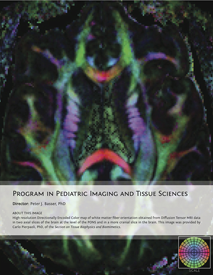You are here: Home > Program on Pediatric Imaging and Tissue Sciences
Program on Pediatric Imaging and Tissue Sciences
Director: Peter J. Basser, PhD
The Program on Pediatric Imaging and Tissue Sciences (PPITS) was created in January 2010, in part to address critical, unmet needs in Pediatric Radiology and to provide a stronger scientific foundation supporting it. This unique Program sponsors a broad range of basic, applied, and translationally oriented research activities aimed at improving the assessment of normal development and at screening, diagnosis, or prognosis of diseases, disorders, or disabilities common in the pediatric population. To this end, PPITS scientists invent, develop, and apply non-invasive imaging methods and modalities and quantitative imaging biomarkers that can sensitively and selectively identify key features of target tissues or organs. An essential and unique feature of this Program is that, to achieve these translational goals, PPITS supports and performs a broad range of basic and applied research in tissue sciences, which aim to identify and characterize potentially salient quantitative imaging biomarkers, as well as in physical, mathematical, and imaging sciences to provide a conceptual framework for their measurement.
Peter Basser heads the Section on Tissue Biophysics and Biomimetics, which strives to understand fundamental relationships between functional properties of soft tissues and their structure in vivo, in "engineered" tissue constructs, and in tissue analogues (e.g., polymer gels). This is achieved by studying complex biological processes and structure/function relationships in an integrative fashion, primarily by probing key processes on length and time scales, as well as by developing and studying relevant biological, mathematical, physical, and computational models and model systems. The Section produced a method based on anomalous X-ray scattering to measure the ion distribution around charged biopolymer molecules and built a tissue micro-osmometer that permits continuous monitoring of water uptake of small specimens. The Section also developed an experimental method to map the elastic properties of tissues and cells. STBB staff invent, develop, and translate novel quantitative in vivo methods for imaging tissues and organs, in particular, new quantitative MRI methodologies to probe tissue microstructure and architectural organization in the brain, and increasingly, in other soft tissues. Recent examples include non-invasive MRI methods to measure and map the diameter distribution of axons within nerve fascicles and to parcellate the cerebral cortex in vivo based on microstructural features. From a clinical and translational perspective, STBB is involved in a wide array of MRI-based studies to migrate these promising new technologies from "bench to bedside.
The Section on Analytical and Functional Biophotonics, led by Amir Gandjbakhche, devises quantitative biophotonics methodologies and associated instrumentation to study biological phenomena at various length scales, from nanoscopic to microscopic. The Section focuses on the translation of technologies and methodologies to the bedside. At the pre-clinical level, the SAFB uses a near-infrared, scanning, time-resolved imaging system to specifically quantify HER-2 receptors in tumor xenografts, with the goal developing a non-invasive immune-imaging system. At the "bedside" level, the Section (i) designed an optical camera, mounted in a conventional colposcope for active polarization imaging of cervical texture while improving statistical tools to enhance visualization of hidden structures (clinical protocol 09-CH-0180); (ii) developed real-time algorithms to assess vascularity in AIDS–associated Kaposi's sarcoma (clinical protocol 08-CH-0001); (iii) developed near-infrared spectroscopy (NIRS) as a noninvasive technique for measuring the local changes in cerebral hemodynamic levels associated with brain activity, a technique that will be used on populations that include patients with traumatic brain injury (children and veterans) and patients with autistic-spectrum disorder, with the goal of developing a small and portable near-infrared instrument with novel neuro-imaging capabilities and translating it to the bedside for use in hospital environments (clinical protocol 10-CH-0198).


